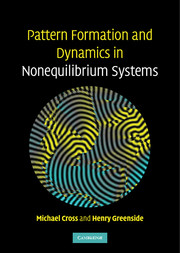Book contents
- Frontmatter
- Contents
- Preface
- 1 Introduction
- 2 Linear instability: basics
- 3 Linear instability: applications
- 4 Nonlinear states
- 5 Models
- 6 One-dimensional amplitude equation
- 7 Amplitude equations for two-dimensional patterns
- 8 Defects and fronts
- 9 Patterns far from threshold
- 10 Oscillatory patterns
- 11 Excitable media
- 12 Numerical methods
- Appendix 1 Elementary bifurcation theory
- Appendix 2 Multiple-scales perturbation theory
- Glossary
- References
- Index
2 - Linear instability: basics
Published online by Cambridge University Press: 05 August 2012
- Frontmatter
- Contents
- Preface
- 1 Introduction
- 2 Linear instability: basics
- 3 Linear instability: applications
- 4 Nonlinear states
- 5 Models
- 6 One-dimensional amplitude equation
- 7 Amplitude equations for two-dimensional patterns
- 8 Defects and fronts
- 9 Patterns far from threshold
- 10 Oscillatory patterns
- 11 Excitable media
- 12 Numerical methods
- Appendix 1 Elementary bifurcation theory
- Appendix 2 Multiple-scales perturbation theory
- Glossary
- References
- Index
Summary
Perhaps the most magical moment in a pattern-forming system is when a pattern first appears out of nothing, the genesis of structure. The “nothing” that one starts with is not empty space but some spatially uniform system. From our study of equilibrium systems, we are used to expecting that if the external conditions are constant in space and time, then, perhaps after some transient dynamics, the system will relax to a state that is time independent and spatially uniform on macroscopic scales. However, as the system is driven further and further out of equilibrium by turning some experimental knob in small successive steps, it is often the case that a point is eventually reached such that a spatial structure spontaneously appears. This is the beginning of pattern formation. In many examples of interest, the novel state with spatial structure develops because the spatially uniform state becomes unstable toward the growth of small perturbations. Analyzing this linear instability provides a first approach to understand the beginnings of pattern formation.
In this chapter, we discuss linear instability: how to predict when a spatially uniform time-independent state becomes unstable to tiny perturbations. We also discuss some details of the growing spatial structure such as its characteristic length and time scales, and how the structure depends on symmetries of the system.
- Type
- Chapter
- Information
- Pattern Formation and Dynamics in Nonequilibrium Systems , pp. 56 - 95Publisher: Cambridge University PressPrint publication year: 2009

